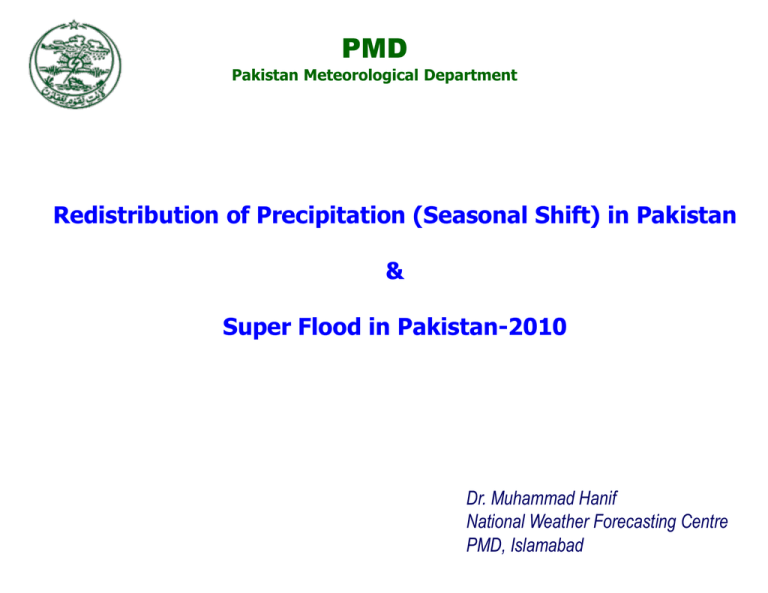SUPER FLOOD (2010) in Pakistan
advertisement

PMD Pakistan Meteorological Department Redistribution of Precipitation (Seasonal Shift) in Pakistan & Super Flood in Pakistan-2010 Dr. Muhammad Hanif National Weather Forecasting Centre PMD, Islamabad PMD Pakistan Meteorological Department SERVICES Meteorology Hydrology Agro-meteorology/Drought Seismology Weather Forecasting System of PMD Data Technique Skill Short Range Weather Forecasts (24 – 48 Hrs): accuracy 90% Medium Range Weather Forecasts (1 – 2 weeks): accuracy 70-80% Long Range/Seasonal Weather Forecasts (1 – 6 Months): Poor Weather Forecasting System of PMD DATA Weather Stations/Observatories Network 80 Rain Gauge Stations 50 AWS Data Bank of PMD (CDPC) Weather Forecasting System of PMD DATA Radar Network of PMD 10-cm Doppler Radars 1- Lahore 2- Mangla QPM Radar 1- Sialkot 5-cm Wx. Surveillance Radars 1- Islamabad 3- D.I.Khan 4- Rahim Yar Khan 4- Karachi Weather Forecasting System of PMD DATA Satellite Ground Stations of PMD HRPT 1- Islamabad 2- Quetta FY-2 E/D 1- Islamabad Weather Forecasting System of PMD Products: Weather Forecasts Rain Temps Winds Weather Forecasting System of PMD Information on Website Climate: Rainfall Distribution Extreme Rainfall Flash Floods Flash Floods in KPK-2010 Monsoon Zone Latitudinal Redistribution of Precipitation in Pakistan In 2007, Zhang et al detected the anthropogenic impact on Global Precipitation. They showed a latitudinal redistribution of mean Global Precipitation, indicating increasing precipitation at high latitudes and decreasing precipitation at lower latitudes. Latitudinal Redistribution of Precipitation in Pakistan Monsoon Rainfall in Pakistan:1951-2000 North South 350 R2 = 0.115 -38° N 250 200 150 R2 = 0.000 100 -30° N 50 1999 1995 1991 1987 1983 1979 1975 1971 1967 1963 1959 1955 0 1951 Rainfall (mm/4month) 300 -22° N Latitudinal Redistribution of Precipitation in Pakistan Terciles: Monsoon Precipitation (1951-2000) Upper Lower 250 Precipitation (mm) 200 150 100 50 0 1950 1955 1960 1965 1970 1975 1980 1985 1990 1995 2000 Latitudinal Redistribution of Precipitation in Pakistan Monsoon Precipitation Shift (80-100 km West) These areas required more attention for water management and to mitigate the flood disasters in the future Previous Current Monsoonal Rain Shift These areas required more attention for water management and to mitigate the flood disasters in the future 100 mm ---- Monthly Rainfall Shift Climate: 1961-1990 Jan Feb Mar Apr May Jun Jul 100 mm ---- Aug Sep Oct Nov Dec Climate: 1991-2010 Climate: 1991-2010 Jan Feb Mar Apr May Jun Jul 100 mm ---- Aug Sep Oct Nov Dec Climate: 2011-2020 Climate: 2010-2020 Jan Feb Mar Apr May Jun Jul Aug Sep Oct Nov Dec 100 mm ---- Wet Monthly Rainfall Shift Wet Dry Winter Monsoon Jan Feb Mar Apr May Jun Jul DRY 100 mm ---WET Dry Climate: 1961-1990 Aug Sep Oct Nov Dec DRY Climate: 1991-2010 DRIER Climate: 1991-2010 Jan Feb Mar Apr May Jun Jul WET 100 mm ---- WETTEST Aug Sep Oct Nov Dec DRIER DRIEST Climate: 2011-2020 Climate: 2010-2020 Jan Feb Mar Apr May Jun Jul Aug Sep Oct Nov Dec Projected Climate: 2020 - 2030 Rainfall Monsoon Winter Mar Apr May Jun Jul Aug Sep Oct Nov Dec Jan Feb Wet Period Dry Period 6 Months (Mar – Aug)…………… Wet Window 6 Months (Sep – Feb)…………… Dry Window Latitudinal Redistribution of Precipitation in Pakistan Due to significant increase in SEASONAL and ANNUAL Precipitation in Pakistan, and the WESTWARD SHIFT (80-100 km) of Monsoonal Rainfall; 1- Rainfall over the Catchment Areas of Eastern Rivers has decreased (moved away). 2- The Probability of occurrence of Heavy Rainfall Events, leading to FLASH FLOODS/FLOODS, would be HIGH over western rivers instead of eastern rivers of Pakistan in the future. 3- Northwest Pakistan (Central parts of KPK & North-western parts of Punjab) are Extremely Vulnerable to Flash Floods/Floods. Pakistan Super Flood: 2010 SUPER FLOOD (2010) in Pakistan: Very Heavy Rainfall 0ver NW Pakistan UN Secretary General Ban Ki-moon visits Sultan Colony, an Internally Displaced Persons’ camp, in Punjab on 15 August 2010 in Multan. UN described the disaster as unprecedented, with over a third of the country under water (Evan Schneider/UN via SUPER FLOOD (2010) in Pakistan: Very Heavy Rainfall 0ver NW Pakistan Army helicopter evacuates stranded villagers in Nowshera, Pakistan on Friday, 30 July 2010. Boats & helicopters struggled to reach hundreds of thousands of villagers cut off by floods in northwest region, this has been the deadliest disaster to hit the region since 1929 SUPER FLOOD (2010) in Pakistan: Very Heavy Rainfall 0ver NW Pakistan Flood victims evacuate their villages in Sukkur, Sindh province following days of heavy rain SUPER FLOOD (2010) in Pakistan: Very Heavy Rainfall 0ver NW Pakistan An aerial view shows a damaged bridge washed out by the floods in Ghazi,5 August 2010 (REUTERS) SUPER FLOOD (2010) in Pakistan: Very Heavy Rainfall 0ver NW Pakistan Survivors walk in the flooded area of Baseera village, Multan, on 10 August 2010. (Arif Ali/AFP/Getty Images) SUPER FLOOD (2010) in Pakistan: Very Heavy Rainfall 0ver NW Pakistan Khyber PK Pakistan received 70.5 % above Normal rainfall in the month of July, 2010 Khyber Pakhtoonkhwa received 179.1% above Normal rainfall in July, 2010 SUPER FLOOD (2010) in Pakistan: Very Heavy Rainfall 0ver NW Pakistan SUPER FLOOD (2010) in Pakistan: Very Heavy Rainfall 0ver NW Pakistan Westerly Wave (Mid Latitude Weather Systems) Monsoonal Zone Monsoon Tracks of Monsoon & Winter Weather Systems SUPER FLOOD (2010) in Pakistan: Very Heavy Rainfall 0ver NW Pakistan Very Heavy Rainfall occurred due to INTERACTION of 2 Weather Systems (Westerly Wave & Monsoonal Wave) over NW Pakistan. SUPER FLOOD (2010) in Pakistan: Very Heavy Rainfall 0ver NW Pakistan July 2010: Disasters in Asia Super Flood (July, 2010) of Pakistan, Extreme HEAT over Russia and Heavy Rains/Landslides over SE China were INTERLINKED. Russian Heat Pakistan Flood North China Heat SE China Rain/LS Due to ENSO-Cycle, the displacement (northward shift) of Subtropical HIGHS perturbed the Jet Stream, leading to Extreme Weather in Asia in July, 2010. SUPER FLOOD (2010) in Pakistan: Very Heavy Rainfall 0ver NW Pakistan Post Analysis of Subtropical Highs (Ridge): 500 mb Jet Stream H H H Subtropical HIGHS (cause of stable/normal climate) SUPER FLOOD (2010) in Pakistan: Very Heavy Rainfall 0ver NW Pakistan Post Analysis of Subtropical Highs (Ridge): 500 mb H H H SUPER FLOOD (2010) in Pakistan: Very Heavy Rainfall 0ver NW Pakistan Post Analysis of Subtropical Highs (Ridge): 500 mb H H H SUPER FLOOD (2010) in Pakistan: Very Heavy Rainfall 0ver NW Pakistan Post Analysis of Subtropical Highs (Ridge): 500 mb H H H SUPER FLOOD (2010) in Pakistan: Very Heavy Rainfall 0ver NW Pakistan Post Analysis of Subtropical Highs (Ridge): 500 mb H H H SUPER FLOOD (2010) in Pakistan: Very Heavy Rainfall 0ver NW Pakistan Post Analysis of Subtropical Highs (Ridge): 500 mb H H H SUPER FLOOD (2010) in Pakistan: Very Heavy Rainfall 0ver NW Pakistan Post Analysis of Subtropical Highs (Ridge): 500 mb H H H SUPER FLOOD (2010) in Pakistan: Very Heavy Rainfall 0ver NW Pakistan Post Analysis of Subtropical Highs (Ridge): 500 mb H H H SUPER FLOOD (2010) in Pakistan: Very Heavy Rainfall 0ver NW Pakistan Winter: 2010/2011 - Subtropical Highs (Ridge): 500 mb H H H Winter 2011: Cold & Dry with Dense Fog L H The Displacement of Sub-Tropical HIGHS, due to current ENSO Cycle (La-Nina episode) caused; 1- Extreme Rainfall over NW Pakistan during Monsoon Season (2010). 2- Deficient Rainfall & Extreme Cold/Fog over Pakistan during Current Winter Season. It is difficult to present an overall indication of the potential impacts of Climate Change in Pakistan. However, the occurrence of recent Extreme Events such as Flood-2010, Deficient Rainfall in Winter and Current Dense and Prolonged Fog are enough to get an Alarming-Attention about a possible Climate Change in Pakistan, having direct and large impacts on several sectors of the society. THANKS









